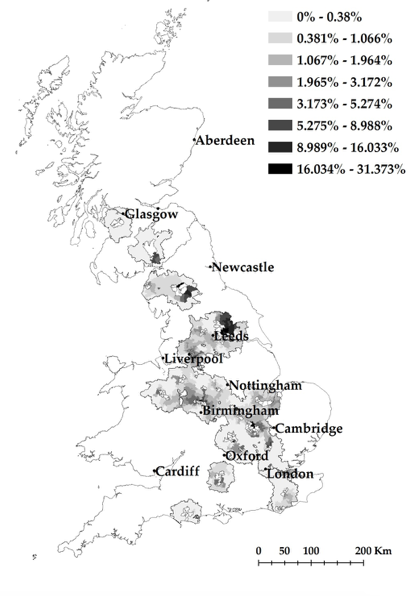Roads dominate transport in most countries, including Britain. According to official statistics, in 2015 89% of passenger miles and around 76% of freight goods movement took place by road. Within the European Union, the corresponding figures for 2014 were 82% and 49% and for the US in 2014, 87% and 45%. In Britain, road traffic has increased ten-fold since the 1950s, up to over 320 billion vehicle miles in 2016. Just over half of these vehicle miles are travelled on the motorway and trunk A-road network.1
Much of the investment in this strategic road network in Britain was carried out in the 1960s-1990s. More recently, investment has declined and over the past decade, capital expenditure on the major national road network has hovered around £1.5-2.5 billion per year in real terms (at 2015 prices), representing about 13-14% of total transport capital spending (TSGB 2016). New government policy initiatives aim to reverse this trend. Road Investment Strategies for 2015-2020 and beyond have promised a new package of strategic road building and improvement, intended to drive the UK’s long-term economic development (Department for Transport 2015, 2016).
Given this renewed interest in road building, it is crucial to know if investment of this type generates economic benefits, either locally or nationally. In theory, road improvements decrease transportation costs for goods and people, improve access to markets, foster economic integration, stimulate competition, generate agglomeration economies, and offer a number of other ‘wider’ economic benefits. This is why transport improvements are frequently proposed as a strategy for economic growth, integration, and local economic development. We have quite a lot of good evidence to support these theories, from periods of rapid network expansion (Duranton and Turner 2012, Michaels 2008, Baum-Snow 2007) and from developing countries (Ghani et al. 2016, Faber 2014, Baum-Snow et al. 2016a). Yet surprisingly little is known about the economic impacts of additional investment in well-developed networks such as those in the UK. Although planned road improvement projects are routinely subject to cost benefit analysis based on the predicted benefits, projects have rarely been subject to any ex post evaluation in order to work out whether the economic benefits actually materialised after the roads were built.
Our research findings
Our paper provides some of the first evidence on this question, suggesting that, even in mature networks, new road investment can produce economic benefits – at least locally (Gibbons et al. 2016). Ours is the first rigorous study to look at the effects of UK road improvements on economic outcomes. We show that places with improved accessibility from new major roads over the 1998-2008 period experienced increases in the number of local firms and, consequently, higher local employment. A 10% increase in accessibility leads to a 3-4% increase in the number of businesses and employment. These gains are common to most industry sectors, although they are not evident in retail, restaurants and related consumer services.
We need to be careful in interpreting these changes as gains to the national economy. To some extent, jobs may be displaced from other areas. Even if not, the aggregate effects from a year of road building do not seem very large. Back-of-the-envelope calculations suggest that, in this ten year period, investment of around £1.8 billion per year, generated around 3,600 additional jobs per year, which equates to as little as £1 billion net present value for each £1.8bn of investment, even if the jobs continue to exist indefinitely.
In contrast to these effects from new firms in the local area, businesses already operating in these areas respond in a slightly unexpected way. Rather than increasing employment, they shed workers, while maintain existing levels of output, implying higher labour productivity. This finding is consistent with other evidence of wage increases for workers in these firms (Sanchis-Guarner 2012). These wage and output effects are similar to the effects on employment: a 10% increase in accessibility results in an increase in labour productivity and average wages of around 2.5-3%.
It would also be fair to say that although we provide a first estimate on the impact of new roads using real world data on actual investments, a number of important puzzles remain. Given how much political attention infrastructure projects attract, it’s clear that improved routine economic evaluation of new schemes is badly needed.
How we did it
To carry out this analysis, we linked administrative data on nearly all individual businesses in Britain from 1998 to 2008, to information on the location of the 31 major road construction schemes that opened nationwide over this period. These schemes were all improvements to the strategic road network (trunk A-roads and motorways). We then used regression analysis to find out whether places and firms that experienced potential road travel time reductions as a result of these new roads saw benefits in terms of employment, number of businesses, output, and other economic outcomes.
There are major challenges when evaluating the economic effects of road construction. The first one is how to capture the effect of new roads, which we do using changes in a continuous index of road network accessibility, calculated at a small geographical scale (electoral ward).2 These accessibility changes are computed from shortest path routes along the major road network. When new links are added to the network, optimal travel times decrease and accessibility increases, but by different amounts according to where a place is in relation to the existing road network and the new road links.
This index measures how easy it is to get from place to all other destinations by road. Figures 1 and 2 illustrate the spatial relationship between road schemes and these accessibility increases. Figure 1 shows new roads and major improvements. Figure 2 shows accessibility improvements between 1998 and 2008 for our main estimation sample (wards within 1-20 km of new links).2
Figure 1 Location of road schemes opened 1998-2008
Figure 2 Changes in log accessibility from 1998 to 2008 – all wards
A second challenge to estimation of the causal impact of road network changes on firm outcomes is that roads may be purposefully built to meet demand in places where productivity is growing or to try to stimulate growth in places where productivity is falling. This would lead us to infer that transport improvements drive economic performance, when the causality is the other way round. To address this problem, we exploit the geographical detail in our data and estimate from the changes in accessibility experienced by wards that are very close to new road projects (within 1-20 km in the main results). This variation amongst local wards is an unintended consequence of improvements to the strategic road network. Improvements to the strategic road network are intended to improve overall network performance and are not aimed at supporting economic development in places close to the project. We can therefore treat this variation in local accessibility as, in effect, randomly generated. Restricting our attention to areas close to schemes results in little loss of generality relative to comparison across the whole country, because most of the variation in accessibility generated by relatively small scale road transport improvements occurs in areas close to new schemes. Our aim then is to infer the more general effects of changes in accessibility from these transport-induced changes occurring at a small geographical level.
References
Baum-Snow, N (2007), “Did highways cause suburbanization?”, Quarterly Journal of Economics 122(2): 775–805.
Baum-Snow, N, J V Henderson, M A Turner, Q, Zhang and L Brandt (2016b), "Highways, Market Access and Urban Growth in China," SERC Discussion Papers 0200, Spatial Economics Research Centre, LSE.
Department for Transport (1997) “A new deal for trunk roads in England: Understanding the new approach” Department for Transport, London.
Department for Transport (2009) Highways Agency Framework Document, Department for Transport, London.
Duranton, G and M A Turner (2011). “The Fundamental Law of Road Congestion: Evidence from US cities," American Economic Review, 101(6): 2616–52.
European Commission (2016) Transport in Figures Statistical Pocketbook, European Union, Luxembourg
Faber, B (2014), “Trade Integration, Market Size, and Industrialization: Evidence from China’s National Trunk Highway System”, Review of Economic Studies, 81(3): 1046–1070.
Ghani, E, A G Goswami and W R Kerr (2016). “Highway to Success: The Impact of the Golden Quadrilateral Project for the Location and Performance of Indian Manufacturing”. The Economic Journal, 126(591): 317-357.
Gibbons, S, T Lyytikainen, H G Overman and R Sanchis-Guarner (2016). "New road infrastructure: the effects on firms," CEPR Discussion Paper No. 11239.
Sanchis-Guarner, R (2012) "Driving Up Wages: The Effects of Road Construction in Great Britain", SERC Discussion Papers 0120, Spatial Economics Research Centre, LSE.
US Department of Transportation (2017) National Transportation Statistics, US Department of Transportation, Bureau of Transportation Statistics.
Transport Statistics for Great Britain (2016), Department for Transport, London.
Transport Statistics for Great Britain (2017), Department for Transport, London.
Endnotes
[1] Sources: European Commission (2016), US Department of Transportation (2017), Transport Statistics of Great Britain (2016), Transport Statistics of Great Britain (2017).
[2] There are 10,300 wards in Britain with an average land area of 24km2 and population of 6,000.
[3] The changes in accessibility between 1998 and 2008 shown in Figure 2 are for descriptive purposes only, as for the estimation of the effects we use within-ward variation.









